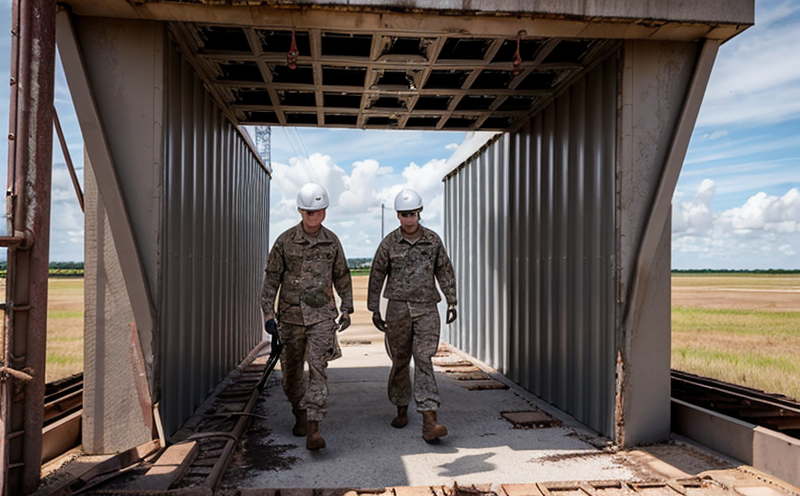Decommissioning inspection
The decommissioning inspection process is crucial in ensuring that equipment and systems are safely removed from service. This inspection plays a pivotal role in identifying potential hazards, preventing environmental contamination, and complying with regulatory requirements. Quality managers, compliance officers, R&D engineers, and procurement teams must be aware of the stringent procedures involved to ensure that the decommissioning process adheres to international standards such as ISO 14023 for lifecycle assessment.
Decommissioning inspections are typically initiated when a piece of equipment or system reaches the end of its useful life. This phase involves a thorough examination of all components, systems, and associated infrastructure. The primary objective is not only to dismantle the equipment but also to ensure that it does so in a manner that minimizes risk to personnel, the environment, and the surrounding community.
The process begins with the initial assessment where all relevant documentation and records are reviewed. This includes maintenance logs, operation history, and any previous inspections or tests conducted on the equipment. Once the preliminary review is complete, the inspection team proceeds to a visual examination of the equipment, checking for signs of wear, corrosion, or other visible defects.
After the initial assessment, advanced non-destructive testing (NDT) techniques are employed to evaluate the internal integrity of the equipment. Techniques such as ultrasonic testing, radiography, and eddy current inspection are used where necessary. These methods help in identifying any hidden flaws that may not be apparent during a visual examination alone.
Adequate documentation is essential throughout the decommissioning process. Detailed records are kept for every phase of the inspection, including the initial assessment, NDT results, and final disposition decisions. This ensures transparency and accountability, which are critical in maintaining compliance with regulatory standards.
The decommissioning inspection also involves a risk assessment to identify any potential hazards associated with the removal process. Measures are put in place to mitigate these risks, ensuring that all personnel involved are protected. Environmental considerations are paramount during this phase, as improper disposal of hazardous materials can have severe consequences for the environment and public health.
Finally, the decommissioning inspection concludes with a final report summarizing all findings and recommendations. This document is critical in guiding subsequent actions, including the safe removal of equipment from service and ensuring that all regulatory requirements are met.
Applied Standards
The decommissioning inspection process adheres to several internationally recognized standards to ensure consistency and reliability across different jurisdictions. Key among these is ISO 14023, which provides guidelines for lifecycle assessment (LCA). This standard helps in evaluating the environmental impact of equipment from its inception through disposal.
Another important standard is ASME PCC-2, which outlines procedures for decontamination and decommissioning. This standard ensures that radioactive materials are safely removed and disposed of without posing a risk to human health or the environment.
In addition to these standards, local regulations must also be considered during the decommissioning process. Compliance with these rules is essential to avoid legal issues and ensure safe operations. For instance, in some regions, specific permits may need to be obtained before commencing any decontamination activities.
Scope and Methodology
The scope of a decommissioning inspection encompasses several critical phases that are integral to the overall process. The first phase involves an initial assessment where all relevant documentation is reviewed, including maintenance logs and operation history. This step ensures that all pertinent information about the equipment’s lifecycle is comprehensively understood.
Following this, a visual examination of the equipment takes place. During this inspection, any visible signs of wear, corrosion, or other defects are noted. This phase provides valuable insights into the condition of the equipment and helps in making informed decisions regarding its disposition.
The next step involves advanced non-destructive testing (NDT) techniques such as ultrasonic testing, radiography, and eddy current inspection. These methods are particularly useful for evaluating internal structures that may not be apparent during a visual examination alone. The results of these tests provide crucial data that informs the final disposition decisions.
The decommissioning process also includes a risk assessment to identify any potential hazards associated with the removal operation. Measures are implemented to mitigate these risks, ensuring the safety of all personnel involved. Environmental considerations are given significant weight during this phase as well, particularly in relation to the safe disposal of hazardous materials.
Finally, the decommissioning inspection concludes with a detailed report summarizing all findings and recommendations. This document is critical for guiding subsequent actions, including the safe removal of equipment from service and ensuring compliance with regulatory requirements.
Eurolab Advantages
EuroLab offers unparalleled expertise in decommissioning inspections, leveraging state-of-the-art technology and a team of highly skilled professionals. Our commitment to quality and safety is reflected in our adherence to international standards such as ISO 14023 and ASME PCC-2.
Our advanced non-destructive testing (NDT) capabilities allow us to provide precise evaluations of equipment integrity, ensuring that all components are safely removed without compromising the environment. Our risk assessment services help in identifying potential hazards and implementing effective mitigation strategies, thereby enhancing overall safety during the decommissioning process.
EuroLab’s extensive experience in this field enables us to offer comprehensive solutions tailored to meet the specific needs of our clients. We provide detailed documentation throughout each phase of the inspection process, ensuring transparency and accountability. Our compliance with local regulations ensures that all operations are conducted safely and legally.
Furthermore, EuroLab invests heavily in research and development to stay at the forefront of decommissioning technology. This commitment allows us to offer innovative solutions that not only meet current standards but also anticipate future regulatory requirements. By partnering with EuroLab, clients can rest assured that they are receiving world-class services that prioritize safety, efficiency, and sustainability.





